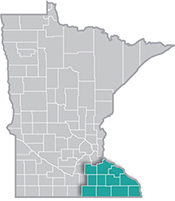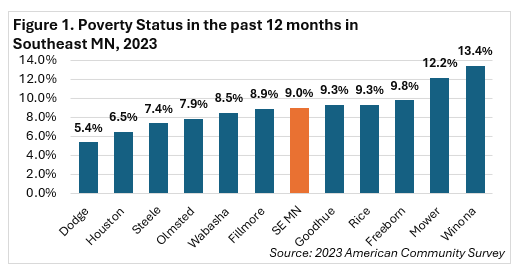 Southeast Minnesota is a health care and agricultural powerhouse. The region is home to the renowned Mayo Clinic and some of the world's most recognized food companies and brands.
Southeast Minnesota is a health care and agricultural powerhouse. The region is home to the renowned Mayo Clinic and some of the world's most recognized food companies and brands.
Advanced manufacturing is especially strong here, with machinery, chemicals, and electronics among the top products.
Want the freshest data delivered by email? Subscribe to our regional newsletters.
4/23/2025 10:52:56 AM
Amanda Blaschko
In 2023, approximately 45,000 residents of Southeast Minnesota lived below the poverty level, representing 9% of the region's population, slightly below the statewide rate of 9.2% (Table 1). While this overall figure suggests relative economic stability for residents, it conceals the complex reality of poverty in the region. This blog examines how poverty rates vary significantly by county, race and ethnicity, sex, and educational attainment, and explores how housing cost burden, particularly among renters, compounds these economic challenges across Southeast Minnesota.
Census data clearly shows that there are racial and ethnic disparities in poverty rates across the region. As shown in Table 1, American Indian residents face the highest poverty rate at 34.8%, closely followed by Black or African American residents at 34.4%, both nearly five times higher than the 7.3% rate experienced by White residents. Hispanic or Latino communities also face elevated poverty levels at 16.5%, substantially above the regional level.
| Table 1. Poverty Status in the past 12 months by Race or Origin in Southeast Minnesota, 2023
(Total population for whom poverty status is determined |
|||||
|---|---|---|---|---|---|
| Southeast Minnesota | Total Population | Income below the poverty level | Poverty Rate (% below pov. level) | Income at or above the poverty level | Minnesota Poverty Rate |
| White Alone | 425,351 | 31,132 | 7.3% | 394,219 | 7.2% |
| Black or African American Alone | 19,485 | 6,698 | 34.4% | 12,787 | 23.4% |
| American Indian Alone | 1,525 | 530 | 34.8% | 995 | 28.8% |
| Asian Alone | 16,374 | 1,512 | 9.2% | 14,862 | 10.8% |
| Some Other Race Alone | 12,052 | 2,062 | 17.1% | 9,990 | 15.6% |
| Two or More Races | 26,254 | 3,355 | 12.8% | 22,899 | 12.5% |
| Hispanic or Latino | 33,220 | 5,495 | 16.5% | 27,725 | 14.8% |
| Total Population | 501,041 | 45,289 | 9.0% | 455,752 | 9.2% |
| Source: 2019-2023 American Community Survey, 5-Year Estimates | |||||
 Similarly, when examining poverty rates across Southeast Minnesota's counties, significant geographic disparities emerge. Winona County experiences the highest concentration of poverty at 13.4%, while Dodge County shows a much lower rate of 5.4% (Figure 1).
Similarly, when examining poverty rates across Southeast Minnesota's counties, significant geographic disparities emerge. Winona County experiences the highest concentration of poverty at 13.4%, while Dodge County shows a much lower rate of 5.4% (Figure 1).
Poverty rates in Southeast Minnesota also vary when examining differences between men and women and across education levels. Women in the region experience poverty at a rate of 9.9%, compared to 8.1% for men, reflecting a gender gap of 1.8 percentage points, which is identical to the statewide disparity. This persistent gender gap highlights economic challenges that disproportionately affect women across the region.
Educational attainment also shows a strong link to poverty rates. Residents over the age of 25 without a high school diploma face the highest poverty rate at 21.1%, though slightly better than the state average of 22.8%. This rate drops dramatically with each educational milestone such as 11.7% for high school graduates, 6.8% for those with some college or an associate's degree, and just 2.6% for those with a bachelor's degree or higher. These educational disparities may help partially explain poverty patterns across the region.
Housing affordability across Southeast Minnesota further illustrates economic disparities and provides important context for understanding poverty in the region. While housing costs are generally lower than state rates (median mortgage payments in the region are at 90% and rental costs are at 85.7% of state medians), housing cost burden, which is defined by the U.S. Department of Housing and Urban Development (HUD) as spending more than 30% of household income on housing costs including utilities, remains a significant challenge for many residents. Nearly half (47%) of Southeast Minnesota renters are cost burdened, compared to only 21.4% of homeowners with mortgages and 14.8% of those without mortgages. The gap between homeowner and renter housing burden helps explain why certain populations struggle to accumulate wealth or escape poverty.
Southeast Minnesota's poverty rate of 9%, while slightly below the state average, reveals important variations across the region. The data shows notable differences in poverty rates between counties, racial and ethnic groups, genders and education levels. Additionally, housing cost burden affects nearly half of renters compared to nearly one fifth of homeowners with mortgages. Understanding these variations provides a more complete picture of social and economic challenges facing different communities within Southeast Minnesota and offers context for the varied experiences of residents across the region.
Contact Amanda Blaschko at amanda.blaschko@state.mn.us.